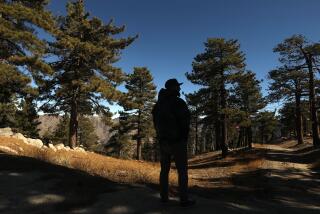Dwindling Open Space
The hilly grassland north of the Ventura Freeway’s Cheeseboro exit may be home to thousands of people a decade from now. The land, known as Jordan Ranch and owned by comedian Bob Hope, is a panorama of fragrant black sage, yellow-flowering tarweed, mountain mahogany, valley oaks, coyotes and swarms of bees. It also is symbolic of a question that politicians, homeowners and environmentalists must wrestle with for as long as there is vacant land left in the state: Will future generations need the open space, or should this generation strike the best deal that it can because development is inevitable?
Potomac Investment Associates, a Maryland-based firm, has an option to buy the land to build 1,550 homes and a tournament-quality golf course. Jordan Ranch adjoins Cheeseboro Canyon in the Santa Monica Mountains National Recreation Area. Developers need 60 acres of the canyon to build a road between the ranch and the freeway.
Last year Daniel R. Kuehn, superintendent of the recreation area, turned down the developer’s request for a right-of-way. Then William D. Fairfield, an attorney for Professional Golf Assn. Tour Inc., asked the U.S. Department of the Interior to reverse Kuehn. Fairfield is a former law partner of William P. Clark Jr., who was the interior secretary from 1983 to 1985. Kuehn’s superiors told him to hear the developers out. They proposed a land exchange, and Kuehn has come to agree that it makes sense.
The developer would get 60 acres for a four-lane road in trade for 800 acres, mostly in the China Flat section on the northwest end of Cheeseboro Canyon. The developer also agreed to sell 230 acres just north of China Flat and another 75 acres near the park’s southern entrance to the Santa Monica Mountains Conservancy for $2 million.
Both Kuehn and the conservancy now argue that the development appears inevitable, that an exchange would leave the park with more land than it could otherwise afford, and that they would retain some leverage on the way development proceeds. If this project isn’t approved, Hope could sell instead to someone who could subdivide the ranch into 80-acre home sites allowed under current zoning. In that case the park would get none of the land now offered to it.
Ideally, the canyon and the ranch should remain as they are. They are open space in a region with dwindling open space. Sen. Pete Wilson (R-Calif.) and others have asked Hope to sell or donate the land to the National Park Service. They should try again. To date, Hope has not been interested. Even if he were, the park service probably could not afford it at its estimated market value of $20 million to $30 million. The park service was criticized for paying $8 million for lower Cheeseboro Canyon in 1985, and federal money has gotten even tighter since then.
Development is not yet inevitable. Speaking of Jordan Ranch and another planned development northeast of the park, Bruce Smith, a Ventura County Planning Department supervisor, said, “On the face of it, the projects appear to be inconsistent with the board (of supervisors) policies.” The park service still owns the 60 acres that the developer needs for a road and whose only alternative would be to buy out 40 separate landowners to secure an alternative route.
The Ventura County Board of Supervisors has the next move. If it decides to approve development, it should limit the number of homes allowed, perhaps even to half the 1,550 now planned. That would reduce the amount of excavation, the need for public services, and the number of automobiles in the arid hills. The county must ensure that the ridgeline between the park and the development is not harmed, that other hilltops are not indiscriminately bulldozed, that as few oaks as possible are lost and that the remaining trees aren’t over-irrigated. It wouldn’t hurt to lower the price on the land being offered the conservancy, either.
Finally, more needs to be done to be sure that the people of Ventura County understand fully what is at stake. Little may be said by the next generation if the land is not developed, but can the county answer for its stewardship if it is?
More to Read
Sign up for Essential California
The most important California stories and recommendations in your inbox every morning.
You may occasionally receive promotional content from the Los Angeles Times.










